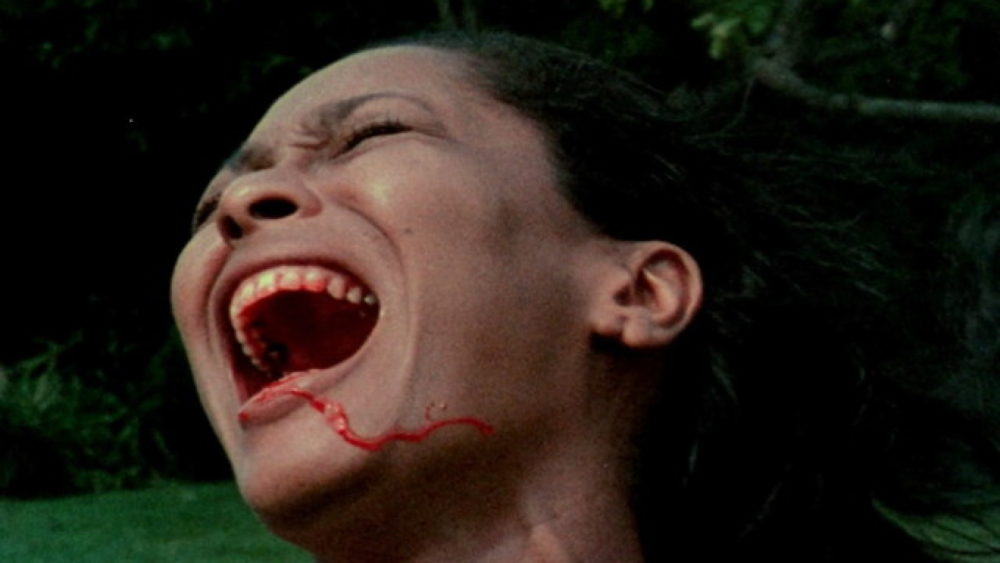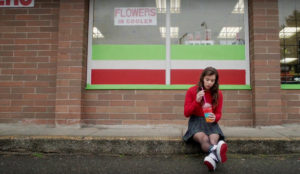
To celebrate Halloween this year, Dim the House Lights will be treating our readers to a horror movie recommendation a day for the ten days leading up to everyone’s favorite holiday. So sharpen your knives, carve your pumpkins, sit back and let the terror take over.
After the surprising success of 1972’s dopey blaxploitation flick Blacula, financiers were keen to cash in on the “black vampire” craze and Bill Gunn’s Ganja & Hess was born. But Gunn, a respected playwright and stage director, had no intention of turning in a daft bloodsucking cheapie, and instead created an impressionistic portrayal of black identity, addiction and pleasures of the flesh.
When Dr. Hess Green (Night of the Living Dead’s Duane Jones) is stabbed with an ancient dagger by a psychologically unstable colleague (Bill Gunn), he develops a thirst for human blood. His colleague commits suicide and Green turns to seducing and murdering young women in poverty-stricken areas to feed his addiction. With the arrival of Ganja (Marlene Clark), the colleague’s widow, Hess forms a romantic relationship before passing his affliction onto her. The two learn to embrace their new lifestyle and work together to lure unsuspecting prey into Hess’s lavish home.
For some, the term “horror movie” might be too simple for something like Ganja & Hess and, certainly for Gunn, somewhat derogatory. It isn’t designed like a horror film nor does it really operate as one. The pacing is languid and the characterization given prominence over body count. It is heavy on dialogue scenes and the stylistic tempo, dictated by the low-budget no doubt, relies on long, static takes furnished with heavy filmic grain. It is one of those 70s movies you find yourself squinting into or raising the volume to decipher.
Despite the rough edges, Gunn’s vision is loud and clear. Ganja & Hess has more in common with other breakthroughs of personal expression in black cinema, Killer of Sheep or Sweet Sweetback’s Badasssssss Song, than something like Blacula or other blaxploitation movies. Like those films by Charles Burnett and Mario Van Peebles, it is edited and structured unconventionally and driven by feeling, moments and texture rather than plot. When characters aren’t talking, the editing takes over and Gunn places us in a trance-like state with a collage aesthetic built up of sounds and culture. There are African chants on the soundtrack as well as snatches of jazz, gospel and blues. It also has an environmental diversity ranging from poverty-stricken streets to upper class museums. The film is an immersion. When Hess dreams, he is haunted by an ethereal image of an African tribe beckoning him. Gunn has an eye on heritage as well as a finger on the pulse of black culture in 1973 America. It is a sensibility so rarely displayed in this genre and quite thrilling to see displayed with such immediacy.
Both Ganja and Hess are rounded, complicated characters too, wonderfully brought to life by Jones and Clark. Gunn’s background on the stage is evident from his emphasis on their faces and their emotion. Both of them work beautifully together and share many of their scenes stripped of clothes. There’s an eroticism running throughout the film, it is sensual and erotic but doesn’t feel like gratuitous nudity to please the genre-hounds. The exposed bodies are a celebration of a skin-tone and race and Gunn gives their entire anatomy equal exposure. In one stand-out scene, Clark is granted an extended close-up to deliver a long, heartfelt monologue that unlocks her character completely for the audience. In this moment, she overtakes Hess as the film’s focus and becomes its star, not as a “final girl” but as a powerful, dominant black woman.
Needless to say, producers weren’t happy with Ganja & Hess when Gunn delivered his final cut, and the film left little impact with an audience despite making a minor splash at Cannes, where it won the Critics’ Choice Prize. It was then heavily recut and shortened to enhance the more straightforward and genre-based elements in the hope of getting investors their money back. Now widely available in Gunn’s original form, it’s easy to see that this is an incredibly individual film. While not a straight-forward horror picture, the film’s unsettling atmosphere and fractured imagery create a psychological unease that places it firmly in that territory. If anything, it is a textbook example of what personal horror filmmaking can achieve when in the right hands. It allows you to tap into a mindset and become moved and disturbed by ideas you may otherwise be ignorant to. Plus, as a film about vampirism it is wholly unique.
If you’ve been reading this feeling an increasing sense of deja vu, it’s probably because Ganja & Hess was re-imagined by Spike Lee as Da Sweet Blood of Jesus in 2014. Lee’s joint is a faithful rendition that successfully re-tunes many aspects to his own sensibility but it lacks Gunn’s hallucinatory spell and deeper meaning. It is an admirable work but perhaps its greatest achievement is leading viewers to discover Ganja & Hess, a great film.
—
Ganja & Hess is available on home video courtesy of Kino Lorber.
Directed by Bill Gunn; written by Bill Gun; Starring Duane Jones, Marlene Clark, Bill Gunn; 112 minutes.



 Derek
Derek
 Isabelle
Isabelle